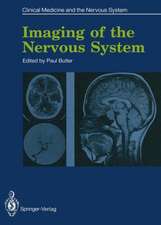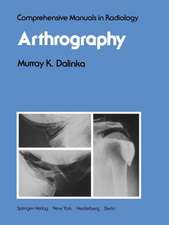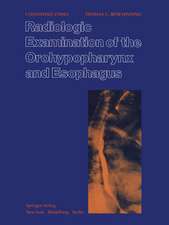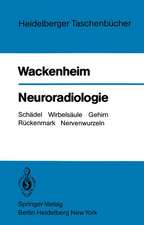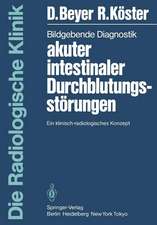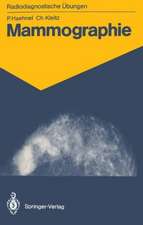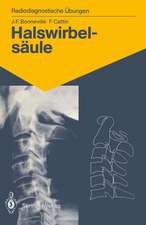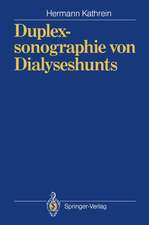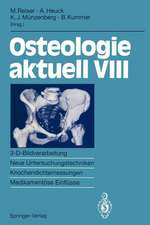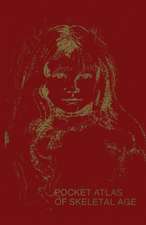Cell Imaging Techniques: Methods and Protocols: Methods in Molecular Biology, cartea 931
Editat de Douglas J. Taatjes, Jürgen Rothen Limba Engleză Paperback – 23 aug 2016
Authoritative and cutting-edge, Cell Imaging Techniques: Methods and Protocols, Second Edition is an easily accessible volume of protocols to be used with a variety of imaging-based equipment likely available in a core imaging facility.
| Toate formatele și edițiile | Preț | Express |
|---|---|---|
| Paperback (1) | 1129.10 lei 6-8 săpt. | |
| Humana Press Inc. – 23 aug 2016 | 1129.10 lei 6-8 săpt. | |
| Hardback (1) | 1385.76 lei 6-8 săpt. | |
| Humana Press Inc. – 2 oct 2012 | 1385.76 lei 6-8 săpt. |
Din seria Methods in Molecular Biology
- 70%
 Preț: 260.97 lei
Preț: 260.97 lei - 23%
 Preț: 598.56 lei
Preț: 598.56 lei - 19%
 Preț: 577.72 lei
Preț: 577.72 lei -
 Preț: 496.79 lei
Preț: 496.79 lei - 20%
 Preț: 882.95 lei
Preț: 882.95 lei -
 Preț: 252.04 lei
Preț: 252.04 lei - 5%
 Preț: 702.04 lei
Preț: 702.04 lei - 5%
 Preț: 703.78 lei
Preț: 703.78 lei - 5%
 Preț: 713.29 lei
Preț: 713.29 lei - 5%
 Preț: 718.90 lei
Preț: 718.90 lei - 15%
 Preț: 638.37 lei
Preț: 638.37 lei - 18%
 Preț: 986.46 lei
Preț: 986.46 lei - 5%
 Preț: 706.80 lei
Preț: 706.80 lei - 18%
 Preț: 879.57 lei
Preț: 879.57 lei - 15%
 Preț: 639.48 lei
Preț: 639.48 lei - 15%
 Preț: 629.39 lei
Preț: 629.39 lei - 18%
 Preț: 1361.06 lei
Preț: 1361.06 lei - 5%
 Preț: 714.51 lei
Preț: 714.51 lei - 20%
 Preț: 821.63 lei
Preț: 821.63 lei - 18%
 Preț: 935.46 lei
Preț: 935.46 lei - 15%
 Preț: 635.52 lei
Preț: 635.52 lei - 5%
 Preț: 710.49 lei
Preț: 710.49 lei - 18%
 Preț: 947.60 lei
Preț: 947.60 lei - 5%
 Preț: 705.56 lei
Preț: 705.56 lei -
 Preț: 392.58 lei
Preț: 392.58 lei - 5%
 Preț: 718.04 lei
Preț: 718.04 lei - 18%
 Preț: 926.18 lei
Preț: 926.18 lei - 23%
 Preț: 860.21 lei
Preț: 860.21 lei - 15%
 Preț: 627.96 lei
Preț: 627.96 lei - 5%
 Preț: 1015.53 lei
Preț: 1015.53 lei -
 Preț: 792.16 lei
Preț: 792.16 lei -
 Preț: 423.62 lei
Preț: 423.62 lei - 5%
 Preț: 425.91 lei
Preț: 425.91 lei -
 Preț: 592.20 lei
Preț: 592.20 lei - 5%
 Preț: 345.62 lei
Preț: 345.62 lei - 5%
 Preț: 372.71 lei
Preț: 372.71 lei - 19%
 Preț: 491.88 lei
Preț: 491.88 lei - 5%
 Preț: 1038.84 lei
Preț: 1038.84 lei - 18%
 Preț: 2041.74 lei
Preț: 2041.74 lei - 5%
 Preț: 1249.97 lei
Preț: 1249.97 lei -
 Preț: 789.93 lei
Preț: 789.93 lei - 5%
 Preț: 1339.10 lei
Preț: 1339.10 lei - 18%
 Preț: 1337.53 lei
Preț: 1337.53 lei - 5%
 Preț: 752.66 lei
Preț: 752.66 lei - 5%
 Preț: 374.89 lei
Preț: 374.89 lei - 18%
 Preț: 1342.68 lei
Preț: 1342.68 lei - 18%
 Preț: 1086.82 lei
Preț: 1086.82 lei - 18%
 Preț: 1354.83 lei
Preț: 1354.83 lei - 18%
 Preț: 1082.26 lei
Preț: 1082.26 lei - 18%
 Preț: 929.67 lei
Preț: 929.67 lei
Preț: 1129.10 lei
Preț vechi: 1188.53 lei
-5% Nou
Puncte Express: 1694
Preț estimativ în valută:
216.10€ • 227.97$ • 180.08£
216.10€ • 227.97$ • 180.08£
Carte tipărită la comandă
Livrare economică 02-16 ianuarie 25
Preluare comenzi: 021 569.72.76
Specificații
ISBN-13: 9781493962464
ISBN-10: 1493962469
Pagini: 550
Ilustrații: XVII, 550 p.
Dimensiuni: 178 x 254 mm
Greutate: 0.98 kg
Ediția:Softcover reprint of the original 2nd ed. 2013
Editura: Humana Press Inc.
Colecția Humana
Seria Methods in Molecular Biology
Locul publicării:Totowa, NJ, United States
ISBN-10: 1493962469
Pagini: 550
Ilustrații: XVII, 550 p.
Dimensiuni: 178 x 254 mm
Greutate: 0.98 kg
Ediția:Softcover reprint of the original 2nd ed. 2013
Editura: Humana Press Inc.
Colecția Humana
Seria Methods in Molecular Biology
Locul publicării:Totowa, NJ, United States
Cuprins
Digital Images are Data – and Should be Treated as Such.- Epi-fluorescence Microscopy.-Live-Cell Migration and Adhesion Turnover Assays.-Multifluorescence Confocal Microscopy: Application for a Quantitative Analysis of HemostaticProteins in Human Venous Valve.-Colocalization Analysis in Fluorescence Microscopy.-A Time-Lapse Imaging Assay to Study Nuclear Envelope Breakdown.-Light Sheet Microscopy in Cell Biology.-Image-based High-throughput Screening for Inhibitors of Angiogenesis.-Intravital Microscopy to Image Membrane Trafficking in Live Rats.-Imaging Non-fluorescent Nanoparticles in Living Cells with Wavelength-Dependent.-Laser Scanning Cytometry. Principles and Applications: An Update.-Laser Capture Microdissection for Protein and NanoString RNA Analysis.-Viewing Dynamic Interactions of Proteins and a Model Lipid Membrane with Atomic Force Microscopy.-Mica Functionalization for Imaging of DNA and Protein-DNA Complexes with Atomic Force Microscopy.-Measuring the Elastic Properties of Living Cells with Atomic Force Microscopy Indentation.-Colocalization Analysis in Fluorescence Microscopy.-A Time-Lapse Imaging Assay to Study Nuclear Envelope Breakdown.-Light Sheet Microscopy in Cell Biology.-Image-based High-throughput Screening for Inhibitors of Angiogenesis.-Intravital Microscopy to Image Membrane Trafficking in Live Rats.-Imaging Non-fluorescent Nanoparticles in Living Cells with Wavelength-Dependent.-Laser Scanning Cytometry. Principles and Applications: An Update.-Laser Capture Microdissection for Protein and NanoString RNA Analysis.-Viewing Dynamic Interactions of Proteins and a Model Lipid Membrane with Atomic Force Microscopy.-Mica Functionalization for Imaging of DNA and Protein-DNA Complexes with Atomic Force Microscopy.-Measuring the Elastic Properties of Living Cells with Atomic Force Microscopy Indentation.-Atomic Force Microscopy Functional Imaging on Vascular Endothelial Cells.-Porosome: The Secretory NanoMachine in Cells.-Stereology andMorphometry of Lung Tissue.-A Novel Combined Imaging/Stereological Method for the Analysis of Human Sural Nerve Biopsies for Clinical Diagnosis.-Correlative Light–Electron Microscopy as a Tool to Study In vivo Dynamics and uUtrastructure of Intracellular Structures.-Photooxidation Technology for Correlative Light and Electron Microscopy.-Electron Microscopy of Endocytic Pathways.-Morphological Analysis of Autophagy.-Cytochemical Detection of Peroxisomes and Mitochondria.-Histochemical Detection of Lipid Droplets in Cultured Cells.-Environmental Scanning Electron Microscopy in Cell Biology.-Environmental Scanning Electron Microscopy Gold Immunolabeling in Cell Biology.-High Pressure Freezing for Scanning Transmission Electron Tomography Analysis of Cellular Organelles.-MALDI Imaging Mass Spectrometry for Direct Tissue Analysis.
Recenzii
From the book reviews:
“The different techniques are described in deep details, the chapters having an abstract, introduction, materials, methods, and, last but not least, notes; each method is described step by step with very, very useful links to the notes. … should be read not only by very specialized scientists, but also by those who usually work with classic microscopic methods, to open their minds and increase their appetite for more precise and complex measurements done on different level of complex biological structures.” (Ioan I. Ardelean, Bulletin of Micro and Nanoelectrotechnologies, Vol. 5 (3-4), December, 2014)
“The goal is to provide seasoned microscopists with a list of protocols to add sophistication to their existing microscopy regimen. The intended audience is experienced researchers who are familiar with imaging in a core microscopy facility. … this book is more useful to microscopists who routinely use microscopic techniques in their research and are knowledgeable about the recent advances in technology. … an ideal reference for a core microscope facility. Each chapter is written independently by a different group of researchers and can stand alone.” (Latha Malaiyandi, Doody’s Book Reviews, December, 2013)
“The different techniques are described in deep details, the chapters having an abstract, introduction, materials, methods, and, last but not least, notes; each method is described step by step with very, very useful links to the notes. … should be read not only by very specialized scientists, but also by those who usually work with classic microscopic methods, to open their minds and increase their appetite for more precise and complex measurements done on different level of complex biological structures.” (Ioan I. Ardelean, Bulletin of Micro and Nanoelectrotechnologies, Vol. 5 (3-4), December, 2014)
“The goal is to provide seasoned microscopists with a list of protocols to add sophistication to their existing microscopy regimen. The intended audience is experienced researchers who are familiar with imaging in a core microscopy facility. … this book is more useful to microscopists who routinely use microscopic techniques in their research and are knowledgeable about the recent advances in technology. … an ideal reference for a core microscope facility. Each chapter is written independently by a different group of researchers and can stand alone.” (Latha Malaiyandi, Doody’s Book Reviews, December, 2013)
Textul de pe ultima copertă
Cell Imaging is rapidly evolving as new technologies and new imaging advances continue to be introduced. In the second edition of Cell Imaging Techniques: Methods and Protocols expands upon the previous editions with current techniques that includes confocal microscopy, transmission electron microscopy, atomic force microscopy, and laser microdissection. With new chapters covering colocalization analysis of fluorescent probes, correlative light and electron microscopy, environmental scanning electron microscopy, light sheet microscopy, intravital microscopy, high throughput microscopy, and stereological techniques. Written in the highly successful Methods in Molecular Biology™ series format, chapters include introductions to their respective topics, lists of the necessary materials and reagents, step-by-step, readily reproducible laboratory protocols, and tips on troubleshooting and avoiding known pitfalls
Authoritative and cutting-edge, Cell Imaging Techniques: Methods and Protocols, Second Edition is an easily accessible volume of protocols to be used with a variety of imaging-based equipment likely available in a core imaging facility.
Authoritative and cutting-edge, Cell Imaging Techniques: Methods and Protocols, Second Edition is an easily accessible volume of protocols to be used with a variety of imaging-based equipment likely available in a core imaging facility.
Caracteristici
Updates the successful previous edition with all new content Provides step-by-step detail essential for reproducible results Contains key notes and implementation advice from the experts Includes supplementary material: sn.pub/extras



